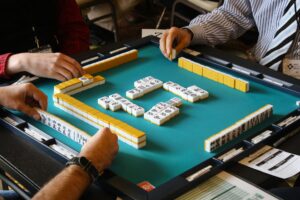 Why learn Chinese by playing Mahjong (麻将, májiàng)? Because it’s both fun and effective!
Why learn Chinese by playing Mahjong (麻将, májiàng)? Because it’s both fun and effective!
One of the most important pieces of advice I give beginner students of Chinese is that they should learn by doing. This can be difficult when you only know a few words, but there are lots of things in your life you can convert to Chinese after just one week of studying.
Tune in to the Hacking Chinese Podcast to listen to the related episode:
Available on Apple Podcasts, Google Podcasts, Overcast, Spotify, YouTube and many other platforms!
The most obvious example is counting. Don’t just study the numbers and learn them for the test, count in Chinese whenever you get the chance! Use 三 (sān, “3”) eggs for your pancakes, do (十二 (shíèr,” 12″) push ups, or count 三十六 (sānshíliù, “36”) steps up to your apartment.
Or you can play games like Mahjong, where you use the numbers all the time!
Learn Chinese by playing Mahjong (麻将, májiàng)
Once you have the basic numbers, down, you’re ready to play Mahjong, or májiàng as it’s written in Pinyin. In this article, I use simplified characters for the name of the game, 麻将, which would be 麻將 in traditional Chinese (read more about simplified and traditional characters here). In the word lists below, I will include both simplified and traditional so you can use the set you prefer, but note that the characters on the tiles in the game are rarely simplified.
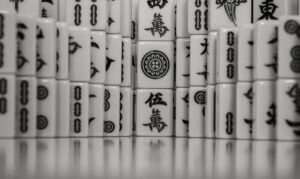 Mahjong is extremely popular throughout the Chinese-speaking world and beyond. It can also be a gateway to Chinese culture, both as it appears in the game and the people you get to know by playing the game. Native speakers are usually impressed when foreigners know how to play their games, which is not limited to Mahjong, but is true for other classic Chinese board games like 象棋 (xiàngqí, “Chinese chess”, not to be confused with Chinese checkers) and 圍棋 (wéiqí, “Go”).
Mahjong is extremely popular throughout the Chinese-speaking world and beyond. It can also be a gateway to Chinese culture, both as it appears in the game and the people you get to know by playing the game. Native speakers are usually impressed when foreigners know how to play their games, which is not limited to Mahjong, but is true for other classic Chinese board games like 象棋 (xiàngqí, “Chinese chess”, not to be confused with Chinese checkers) and 圍棋 (wéiqí, “Go”).
Learning Chinese by playing Mahjong is also great fun!
Apart from the numbers 1-9, you only need a handful of words and most of them are useful outside the game as well. I have played in Chinese with people who don’t even study Chinese, so it’s definitely doable for zero beginners. From a language point of view, playing mostly consists of naming the tiles you play and, sometimes calling an action based on what someone else just played. Naturally, Chinese people tend to talk a lot while playing the game, but we’ll focus on the game itself here.
How to play Mahjong in Chinese
The easiest way to get the hang of the rules of Mahjong is to think of it as a card game (which it originally was). The game is played by drawing one new tile to your hand each round, then discarding one. Gradually, you upgrade the tiles you have on your hand until all tiles are part of different sets of three or four of the same tile or three tiles with consecutive numbers (a straight). The first person to combine all his or her tiles in this way wins.
There are many different ways to play the game depending on where you are. Some of thees variations have a huge impact on how the game is played, but others are mostly cosmetic. Since we are interested in learning Chinese here, rather than winning competitions, I will not discuss specific rule sets and variants. Still, unless you have played the game a lot within a certain community, you need to check how they play the game, even if you think you know how it works. There are also many rules that have no impact at all, but that are important to many players, such as exactly how to setup the game, how to determine who goes first, and so on. Let your Chinese friends deal with this, or if you play with other foreigners, do whatever you like.
If you want a beginner-friendly introduction of how to play, check this video on YouTube (in English). You can also check the Mahjong Competitions Rules (MCR) on Wikipedia.
Scoring in Mahjong
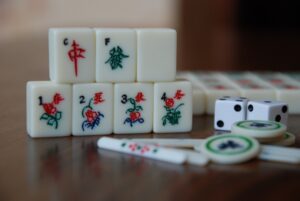 I have played Mahjong a lot with different native speakers, and even though the basic premise of the game stays mostly the same, the scoring system can be completely different.
I have played Mahjong a lot with different native speakers, and even though the basic premise of the game stays mostly the same, the scoring system can be completely different.
If you care about games and want to play well (I do), this is frustrating, because changing the scoring system changes the way the game ought to be played. Also note that many native speakers put real money on the line when playing, but unlike in most variants of Poker, this is not an integral part of the game, so playing for points or valueless tokens is fine.
For some reason, there was a Mahjong craze in Sweden in the 80’s, so I actually learnt to play the game as a child. The scoring system we used was unnecessarily complicated, and I never really understood why. Later, when playing with native speakers, it turned out that most used a system that both easier and better!
Solitaire versions of Mahjong
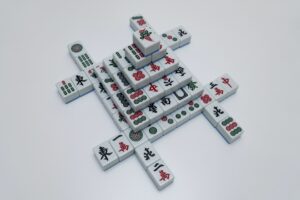 There are many solitaire games that use the Mahjong tiles, but these have nothing to do with the game I’m talking about here. These games are normally about matching tiles arranged in various patterns with the end-goal of removing all the tiles. There are also games for several players where tiles are played face-up much like when playing Dominoes, but again, this is not real Mahjong.
There are many solitaire games that use the Mahjong tiles, but these have nothing to do with the game I’m talking about here. These games are normally about matching tiles arranged in various patterns with the end-goal of removing all the tiles. There are also games for several players where tiles are played face-up much like when playing Dominoes, but again, this is not real Mahjong.
While these variants of Mahjong can be fun, they offer little or nothing for us language learners, so I have omitted them from this article. I thought I’d mention that they exist, though, to avoid confusion. You can still play real Mahjong on your own against AI opponents, of course, but more about that later!
Learn Chinese by playing Mahjong with these word lists
Below, I have included the basic vocabulary you need to play. There are more useful words than these, and there are also variants of some of them, but this is just meant to get you started, not teach you everything there is to know. There are also regional variants, so don’t be surprised if this list isn’t identical to what you have heard or what your Chinese friends teach you. Most of the words are universal, though. First, here’s an image of what the tiles look like:
- Bonus tiles plus dice
- The four winds, the three dragons and two blank tiles
- The characters suite (1-9)
- The bamboo suite (1-9)
- The circles suite (1-9)
Numbers
- 一 (yī) “one”
- 二 (èr) “two”
- 三 (sān) “three”
- 四 (sì) “four”
- 五 (wǔ) “five”
- 六 (liù) “six”
- 七 (qī) “seven”
- 八 (bā) “eight”
- 九 (jiǔ) “nine”
General
-
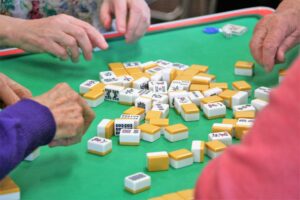
洗牌 (xǐpái) “shuffle tiles (or cards)”
- 出牌 (chūpái) “play a tile”
- 摸牌 (mōpái) “draw a tile”
- 自摸 (zìmō) “to draw a tile yourself (often to win)”
- 和了 (húle) “I’ve won!”
- 吃 (chī) said when you take a tile to complete a straight (usually “chow” in English)
- 碰 (pèng) said when you take a tile to complete a set of three (usually “pong” in English)
- 槓 (gàng) said when you take a tile to complete a set of four (usually “kong” in English)
Normal tiles
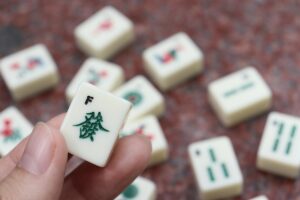 筒 (tǒng) “circle (suite)”
筒 (tǒng) “circle (suite)”- 条/條 (tiáo) “bamboo (suite)”
- 万/萬 (wàn) “characters (suite)”
- 东风/東風 (dōngfēng) “east wind”
- 南风/南風 (nánfēng) “south wind”
- 西风/西風 (xīfēng) “west wind”
- 北風 (běifēng) “north wind”
- 红中/紅中 (hóngzhōng) “red dragon” (lit. “red centre”)
- 发财/發財 (fācái) “green dragon” (lit. “make a fortune”)
- 白板 (báibǎn) “white dragon” (lit. “white board/slate”)
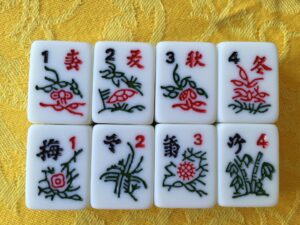 Bonus tiles
Bonus tiles
- 春 (chūn) “spring”
- 夏 (xià) “summer”
- 秋 (qiū) “autumn”
- 冬 (dōng) “winter”
- 梅 (méi) “plum blossom”
- 兰/蘭 (lán) “orchid”
- 菊 (jú) “chrysanthemum”
- 竹 (zhú) “bamboo”
Please note that the bonus tiles merely add randomness to the game and are therefore generally excluded from competitive play.
Extra
- 门前清自摸/門前清自摸 (ménqiánqīng zìmō hú) “to win by only drawing tiles from the wall” (see this comment for an explanation of the phrase)
If I’ve missed anything important, please leave a comment below!
Learn Chinese by playing Mahjong with native speakers
 As mentioned earlier, I’ve played a fair amount of Mahjong games in Chinese with native speakers, and the only drawback is that if you’re not already quite good at the game, it’s hard to chat and play at the same time. Experienced players usually play while talking about other things, don’t call out tiles and use hardly use any of the vocabulary listed above, except when calling the attention to something important.
As mentioned earlier, I’ve played a fair amount of Mahjong games in Chinese with native speakers, and the only drawback is that if you’re not already quite good at the game, it’s hard to chat and play at the same time. Experienced players usually play while talking about other things, don’t call out tiles and use hardly use any of the vocabulary listed above, except when calling the attention to something important.
It can also be hard to keep up, because many people play very fast and have long since forgotten what it was like to be new to the game.
Don’t be afraid to ask them to slow down a bit and to call out the names of the tiles they play. If you don’t understand what’s going on and tiles just seem to fly around without rhyme or reason, it won’t be fun and you won’t learn much Chinese either. You can always let them play without you later if you think you’re intruding too much.
In my experience, Chinese people are usually welcoming to foreigners playing with them. You might not be invited to the high-stakes games late at night, but that isn’t the point!
How to get better at playing Mahjong and learn more Chinese
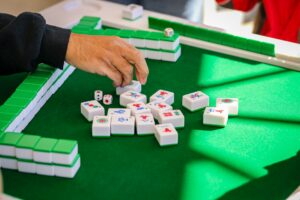 Mahjong is like most other card games where you draw and discard cards to complete sets. You need to be mindful of what you are doing, what you think the opponents are doing, and potential risks and benefits of each play.
Mahjong is like most other card games where you draw and discard cards to complete sets. You need to be mindful of what you are doing, what you think the opponents are doing, and potential risks and benefits of each play.
There’s also a fair amount of luck involved, so even someone who plays perfectly will often lose. Naturally, over longer games (a full game consist of at least 16 rounds), luck evens out and strong players prevail over weaker ones more often than not.
A good tip if you want to familiarise yourself with the game on your own is to download a Mahjong app and have a go. If you have any specific recommendations for good apps, please leave a comment! If you want recommendations for good apps, there are already plenty in the comment section already, so check those out!
10 ways of using games to learn and teach Chinese
Mahjong is just one example of a game that can help you learn Chinese. In fact, games are powerful learning tools if used properly. This is true not just for classic Chinese board games like Mahjong, but all games! Read more here: 10 ways of using games to learn and teach Chinese
https://www.hackingchinese.com/10-ways-using-games-learn-teach-chinese/
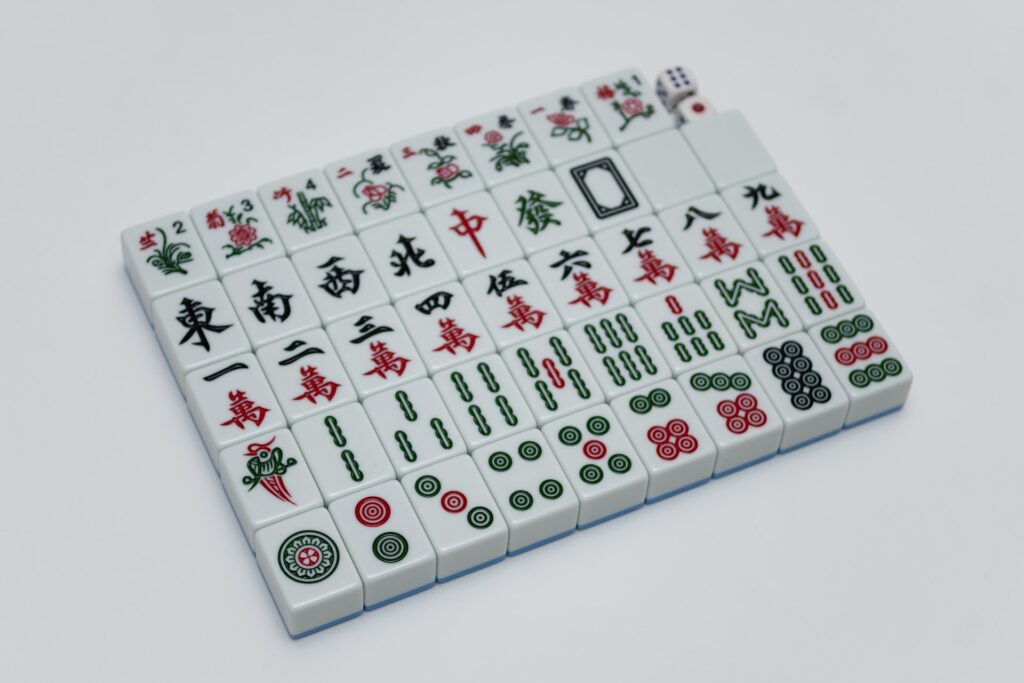

24 comments
Very helpful! I have looked up for smartphone apps but there seems to be many different kinds of them. Can you recommend one that is traditional mahjong? Thank you
Sorry, no, but perhaps someone else knows? I’ll add a question to the article. I used to play on my computer, but I’m using Linux and it was three years ago, so it probably wouldn’t help you even if I remembered what program I used. 🙂
Geoff W. recommends:
I found the Tencent app quite good: http://majiang.qq.com/m/
There is a simple mode to learn, which I’m finding helpful, as the network version I keep losing.
Great article! Maybe I will finally need look at that as well – every time Chinese New Year or any longer holidys start here in Taiwan and my wife returns home – 回家 – especially in Hakka community in 苗栗 – never ending Majong’s starts in every and single house in the area. I felt extremely boring looking at that, but maybe just because I did not knew the rules (did not want to know).
Hi,
Do a web search for ‘real mahjong’. Here’s a video of one for Mac:
https://www.youtube.com/watch?v=wSA5xyYHV1s
Four Winds Mahjong for iPad looks even better as it helps beginners learn.
I haven’t tried any of these, but I used to play mahjong as a child in the UK on a set my parents brought back from India.
Cool! I actually learnt the game as a child too, long before I knew anything about Chinese. My parents don’t speak any Chinese, but there was a kind of Mahjong craze in Sweden around that time (not sure why). I only learnt to play in Chinese twenty years later!
Also, thank you for the app suggestions!
Hey, great article. I learned to play it as a way to interact with my wife’s friends and family, before I learned Chinese.
After I learned Chinese I picked up the terms, and the meaning behind what they were saying, but I never formally read up on it.
Thank you for the characters and pinyin. I have been saying 槓 (gàng) without the last ‘g’ for a long time.
One tile you forgot about were the flower tiles. Not everyone plays with them, but it would be good to mention them in case some one encountered them.
Another benefit of learning both the game and terms is that it impresses people. Many Chinese college students I met thought learning it was hard, and were impressed that I had learned the game.
Hi Olle, great topic! Perhaps a similar article could be written about 斗地主 in the future, which is being played in many Chinese parks and side streets.
Anyone has a recommendation for an Android real mahjong app to practice?
“Hong Kong Style Mahjong” looks pretty good on Android, but I haven’t played it yet:
https://play.google.com/store/apps/details?id=com.pvella.mahjong
Nice article, specially for the related vocabulary.
It would be nice to see other articles about other popular Chinese games such as 象棋, 五棋 and 斗地主.
I think I’ll need to print this post out and carry this with me if invited to a mahjong play… I can’t play mahjong and I’m actually a native speaker of Mandarin… which is quite embarrassing actually, I guess? ^_^””
For some reason I’d never been able to learn to play mahjong as a kid, I just couldn’t seem to figure out the rules, let alone the vocabs they use in the play. Never understood what the adults playing mahjong were mumbling grumbling about. Poker games are a bit easier to me, strange to say. Meh. : /
Thanks again for… this nice simple post on mahjong play! 改天來試試看!
Please will you add how to say “your turn”?
And some phrases like “oh no” and “yay” could be fun hehe – anything someone might say while playing a game with friends
Please will you also add “beauty tile” and “gàng tile”?
How do you say “I’m calling”? (If that is indeed what you’re supposed to say when you need one more tile to win!)
What do you say when you have won the game?
Vocabulary item number 4 in the general list!
Great Blog! Keep on posting
I believe the pinyin for 围棋 should be wei2qi2.
Oh, good catch, thanks! I’ve fixed the typo.
Any idea what this is? I’m told it’s maybe the name of turning over your winning hand?
https://imgur.com/a/ckahh9o
Here’s a plain text version of the phrase with spaces between words to help you parse it: 门 前清 自摸 和/門前清 自摸 和. As usual in Chinese, things that describe something comes before the thing they describe, so let’s explain each word in reverse order to make sense of the phrase:
和 means to win, so this phrase describes a special kind of win.
自摸 means to draw a tile yourself rather than picking up a tile discarded by another player. This word is common on its own and together with 和 as well, as it’s not that uncommon to draw the winning tile yourself.
门 前清 means that you draw all the tiles throughout the whole game yourself, without relying on a single discarded tile. The literal meaning is “clear in front of one’ door”, meaning that there are no tiles in front of you on the table.
Thus, if you combine all of these, you get a rather unlikely event where a player wins only by drawing tiles from the wall! Lucky indeed!
The player that the game begins from(that also gets credit from making a triple with 東) is called zhuang1 but I don’t know the hanzi for it, can you add it in please? Also the credit system is tai2, which I don’t know the hanzi for either 😛 and maybe add some popular combos like 平和, 臭平和, 对对碰,十三幺 etc. The term for calling a win but actually failing to do so is called 炸和(zha4 hu2) which is really only used among beginners because they may mistakenly call a win when they didn’t. Can’t think of many more off the top of my head but I think these are some cool ones to add.
The zhuāng you’re looking for is 庄/莊, and the full word is 庄家. The tái in the scoring system is 台. I’ll make sure to include these and some of the others you mentioned next time I update this article, thank you for the comment! 🙂
Great article!!! I’ve been trying different apps and I like “World Mahjong 2.0” the best so far. It’s available on different platforms as well (even on Steam!).